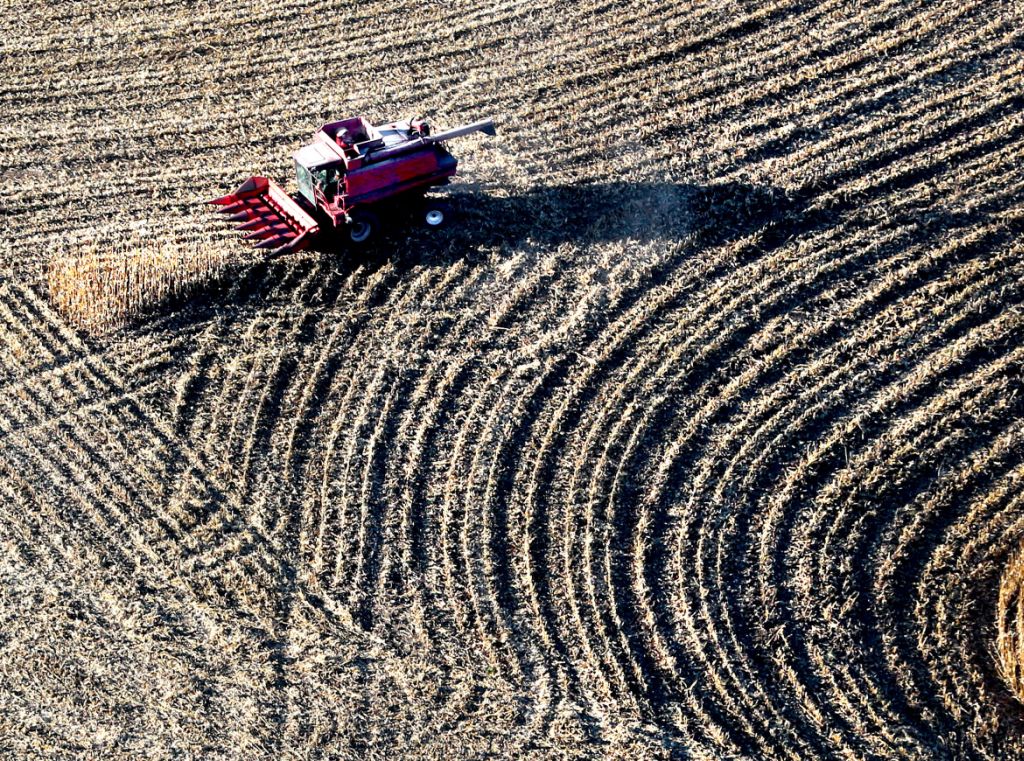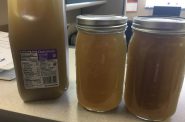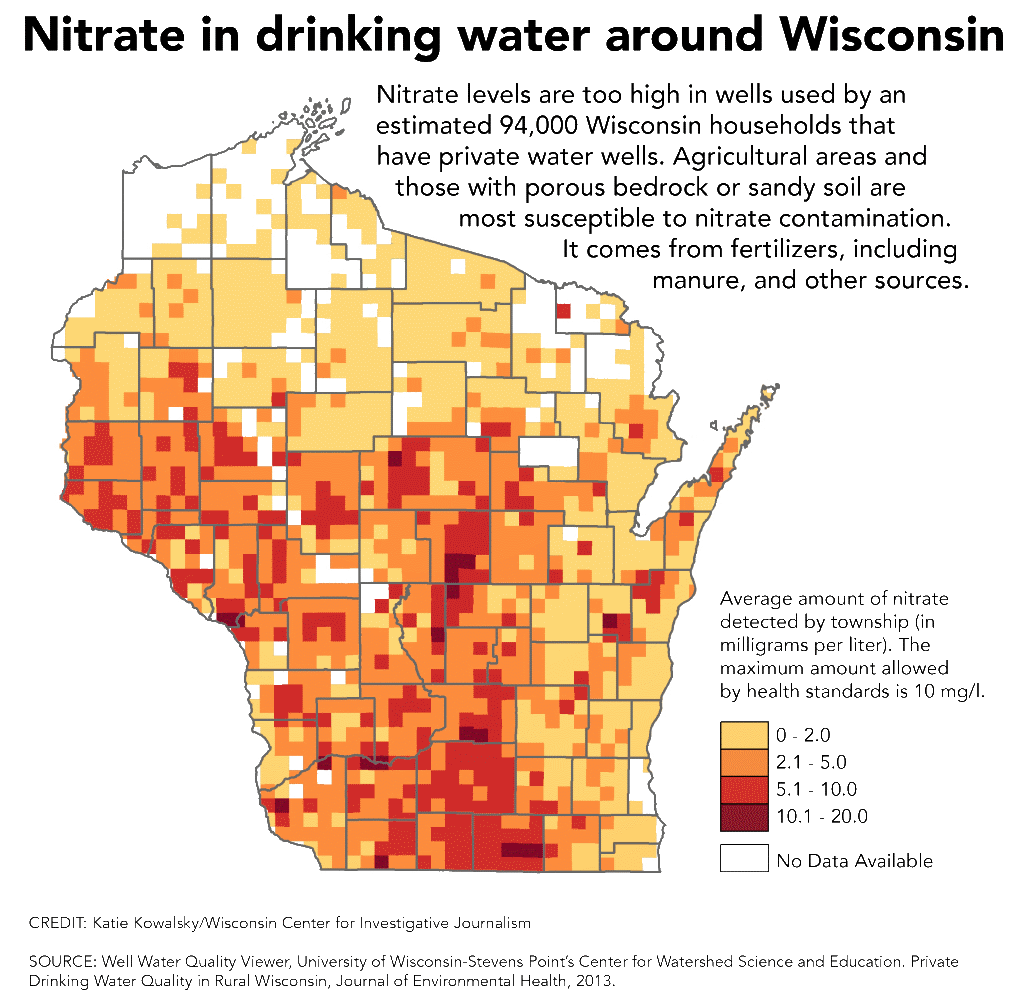Nitrate Pollutes State’s Drinking Water
Chemical is at unsafe levels in estimated 94,000 Wisconsin households.

Land use is a factor boosting the level of nitrate in the water in Wisconsin. In the Upper Midwest, millions of acres of grassland — which leaches little nitrogen into aquifers — have been converted into fields of corn, soy and other crops since 2008, according to University of Wisconsin-Madison researchers. Here, a farmer harvests corn near Blair in Trempealeau County. Photo by Erik Daily of the La Crosse Tribune.
Born a month early in the spring of 1999, Case 8 had been thriving on formula. But at three weeks old, when her family ran out of bottled water and started using boiled water from the household well at the dairy farm where they lived, she got sick.
She was just 4 pounds, 10 ounces, when her parents brought her to a Grant County emergency room. Cold, pale and “extremely blue,” she was rushed by helicopter to a regional intensive care unit.
Nearly all of her red blood cells had lost the ability to carry oxygen, according to medical records Wisconsin public health officials summarized in the Wisconsin Medical Journal.
Two days after she fell ill with methaemoglobinaemia, or “blue baby syndrome,” water tests turned up the most likely culprit — high levels of nitrate.
According to state estimates, nitrate is at unsafe levels in an estimated 94,000 Wisconsin households. One in five wells in heavily agricultural areas is now too polluted with nitrate for safe drinking, according to data from the state Department of Agriculture, Trade and Consumer Protection.
And public water systems recorded 57 violations of health-based standards for nitrate in 2014. Those systems were required to post notices, provide bottled water, replace wells, install treatment or take other corrective actions to reduce nitrate. More than 120 of the 11,420 systems failed either to monitor or report nitrate levels.
“Nitrate that approaches and exceeds unsafe levels in drinking water is one of the top drinking water contaminants in Wisconsin, posing an acute risk to infants and women who are pregnant, a possible risk to the developing fetus during very early stages of pregnancy, and a chronic risk of serious disease in adults,” according to the 2015 Wisconsin Groundwater Coordinating Council report to the Legislature.
The multi-agency council also reported that nitrate — one of the most pervasive groundwater contaminants in Wisconsin — is “increasing in extent and severity.”
Despite the signs of trouble, Wisconsin’s most recent in-depth look at blue baby syndrome is more than a decade old.
State health officials identified eight cases in the 1990s. All recovered — including Case 8, who was released from the hospital after 17 days. Generally, a baby can recover in one or two days once given clean water.
New studies have suggested even the current health standard for nitrate may be too high.
Yet blue baby syndrome is rare. That is probably because private well owners have been warned for decades to test their water, especially if they have a baby. But over the past four decades, the contamination has been worsening in extent and severity.
Among those with water contaminated by nitrate are Sherryl and Doug Jones of rural Spring Green.
About eight years ago, water from their private well tested at 20 milligrams of nitrate per liter of water — twice the health limit. Sherryl Jones said the couple initially switched to bottled water and, since 2012, they have been using a reverse osmosis system to remove nitrate at a cost of about $25 a month. Reverse osmosis removes nitrate and other contaminants by using high pressure to push water through a semipermeable membrane.
“We had children, we had babies in our house, we had a pregnant daughter, we had pregnant daughters-in-law. What was this (water) doing? There was no way we could let them drink this water,” Sherryl Jones recalled.
Jones said she urged neighbors to get their water tested, too. The result: Some of them had been drinking water with four times the health limit of nitrate. In fact, testing by the University of Wisconsin-Stevens Point’s Center for Watershed Science and Education found 31 percent of the private well samples collected in the Spring Green area had nitrate levels above the health standard.
Sherryl Jones said the DNR never warned them about high nitrate levels in the beautiful area along the Wisconsin River where they built their dream home. State officials have been studying dangerous nitrate levels private water wells in the Lower Wisconsin River Valley at least since the early 1990s.

Ian Torkelson runs a test for the presence of nitrate and phosphorous in water at the University of Wisconsin-Stevens Point’s Center for Watershed Science and Education. Nitrate from fertilizers, including animal manure, and human waste has polluted numerous wells in Wisconsin. Photo by Debra Sisk of the University of Wisconsin-Stevens Point.
“They’ve known about it. Now, what have they done?” she said. “They haven’t even educated the residents of this area.”
Tainted Water
-
Fecal Microbes In 60% of Sampled Wells
 Jun 12th, 2017 by Coburn Dukehart
Jun 12th, 2017 by Coburn Dukehart
-
State’s Failures On Lead Pipes
 Jan 15th, 2017 by Cara Lombardo and Dee J. Hall
Jan 15th, 2017 by Cara Lombardo and Dee J. Hall
-
Lax Rules Expose Kids To Lead-Tainted Water
 Dec 19th, 2016 by Cara Lombardo and Dee J. Hall
Dec 19th, 2016 by Cara Lombardo and Dee J. Hall



















